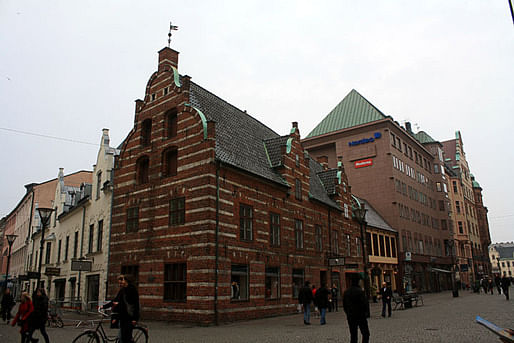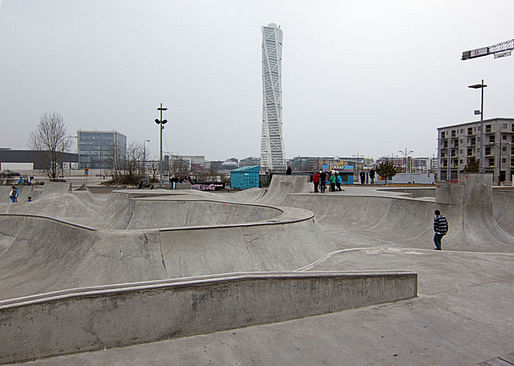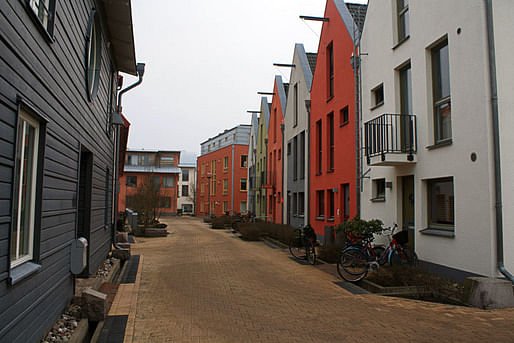
Part II of Spring Break installment
Just 15 miles beyond the windmills of Copenhagen’s shore we have Malmö, a Swedish city that has boldly rebranded and reconceptualized itself over the past decade.

Malmö skyline from atop the ferry as we leave Copenhagen for Oslo. This panorama was taken with a telephoto lens; Calatrava's Turning Torso tower is normally the only structure visible from Copenhagen.
Once home to one of the most prominent shipyards in Europe and the iconic Kockums Crane, the industry went bankrupt in the 1990’s and Malmö saw its economic lifeline and identity slipping. The city has since made a conscious decision to transform itself from an industrial city into a city for people, students, culture, and new high tech business.
Through an aggressive agenda of phased investments in infrastructure, transportation, new housing, old housing, museums, universities, libraries, and business centers, and strict energy policies, Malmö is now a city of 300,000 (the third largest in Sweden) that is still very much on the rise. It is on track to reach carbon neutrality by 2020.
20 minutes by train from Copenhagen, we spent one full day exploring its streets. Here are our sights sounds and observations:
Designed by Arup and opened, in 2000, the Øresunds Bridge is the longest car/rail bridge in Europe and connects Sweden to Denmark. The construction of this bridge was fundamental in reviving Malmö; it is very easy to commute back and forth, and in fact, many of Malmö's residents work in Copenhagen.
 Panorama of the nearly 5 mile long Øresunds Bridge
Panorama of the nearly 5 mile long Øresunds Bridge
The Downtown of Malmö has gone through extensive development through several phased strategies conducted by Gehl Architects in an effort to highlight usable and livable space. There is a wealth of jugendstil and medieval architecture within the fabric of the streets.  Jugendstil
Jugendstil  Former royal/military fortress/prison - today's museum of Malmö's history
Former royal/military fortress/prison - today's museum of Malmö's history
Malmö coat of arms
Alex and his new friend Traditional Windmills
Traditional Windmills
An Educated and Cultured City
Part of the City's progressive push to rebrand itself had to do with heavily investing in new cultural institutes.  Main reading room of Malmö City Library, Henning Larsen Architects
Main reading room of Malmö City Library, Henning Larsen Architects

"Study cubes" Malmö City Library, Henning Larsen Architects

Malmö Museum of Modern Art, Tham & Videgård Arkitekter

The museum is actually a retrofitted firestation
Swedish colored lockers
The most impressive is the current transformation of the Västra Hamnen, or Western Harbor. The former location of the Kockums Shipyard, this large swath of land develops piece-by-piece with new neighborhoods in a carefully planned schedule of mixed-use apartments, progressive residential neighborhoods, park space, playgrounds, offices, and perhaps most importantly, a reclaimation of the waterfront. With the exception of the Turning Torso, the overall scale is more modest and human than the Ørestad development we discussed in our last post. The size, however, felt just as tremendous. The vision is far from complete, and we saw as many cranes as we did new buildings.

Photo of poster advertising things to come. From what we saw, about 1/3 is complete, 1/3 under construction, and 1/3 is vacant
Calatrava's Turning Torso was built as a new landmark to replace the iconic Kockums Crane that was torn down, along with the hopes to engender another Bilbao effect. In this regard, the tower was very successful, and served as a great aid in orienting our meander through the Vastra Hamnen (and even the downtown). A nice attribute to the tower is its dynamicism; as you navigate through the city, it provides a playful variety of new views, angles, and visual anchors that enhance the sense that the tower is bending back and forth. It is the tallest tower in Scandinavia at 623 feet.
We were, however, quite disappointed with the tower up close. The entry space and engagement with the street fabric is introverted and almost paranoid; the tower is surrounded by a moat. It is also aging terribly with stains running down the cladding from underneath nearly every window. We feel that this is unacceptable for a building less than seven years old.
 Skatepark for Vastra Hamnen, and the Kockum's Crane identity replacement
Skatepark for Vastra Hamnen, and the Kockum's Crane identity replacement The various and playful corkscrewed forms
The various and playful corkscrewed forms
Of the various neighborhoods within the Västra Hamnen, the development Bo01, has become the most publicized. Located on the western shore of the harbor, the housing development was built for the European Housing Expo in 2001 and touted as the "City of Tomorrow".
Bo01 is self-sustaining development in many senses. As a neighborhood, there are restaurants, businesses, retail, parks and playgrounds. Streets prioritize pedestrian access, creating a more intimate community. Bo01 minimizes its impact on the environment through solar and wind power, recycling organic materials for biofuel, and reusing rainwater runoff.
The neighborhood has been criticized by some that the development is too exclusively wealthy, and indeed, it is the most expensive place to live in the Vastra Hamnen. Unlike it's neighboring development of Flagghusen to the north (which provides more affordable apartments), Bo01 was well-funded by the government (because of the Expo), receiving 250 million USD in contributions towards undertaking environmentally sensitive initiatives. Counterarguments to the criticism say that regardless of the pricing, the development gives back public space along its nicely reclaimed water front. Indeed this seemed to be the case, as on the cloudy and damp Sunday we visited, there were plenty of people out enjoying the waterfront.

Though it was built at the same time under one master plan, the many homes of Bo01 were intentionally designed by different architects in an attempt to create a diverse architectural language.
Inside Bo01, the homes are interlaced with an irregular grid of pedestrian streets, canals, squares, and gardens. The homes felt personable and there was plenty of street life.

A very fun place to explore. Terminating vistas and alleys
Terminating vistas and alleys
While fascinated, we remain slightly skeptical about some aspects of the Western Harbour, particularly with the developments that are not as well funded as Bo01. It seems to be a great gamble to lay out a new city of sorts without allowing it to grow into itself naturally. Some spaces felt somewhat sterile and fake. Regardless of the reaction, one can't help but admire the optimism and audacity to take on the challenge of redeveloping a former shipyard to this extent. The vision that Malmö seeks to aspire as they break in their new identity is quite inspiring. It will be interesting to return in 10 years.

This work by A.D.Morley & J.A.Wong is licensed under a Creative Commons Attribution-NonCommercial-NoDerivs 3.0 Unported License.
A new adventure begins as we finish one chapter; we hope to share our story with you. We are graduates of Washington University in St. Louis, Sam Fox School of Design & Visual Arts.
No Comments
Block this user
Are you sure you want to block this user and hide all related comments throughout the site?
Archinect
This is your first comment on Archinect. Your comment will be visible once approved.